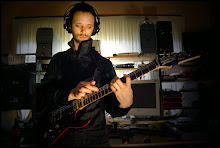Audio Arts Week 1 – Introduction to Game Sound
Audio Arts Week 1 – Introduction to Game Sound
 | Asteriods - Classic space blasting action |
Asteroids, while not the most graphically spectacular of Atari games, is an addictive and memorable experience nonetheless.
After following the link above and having a play on the emulator, you’ll see that this is one of those ye-oldie two dimensional masterpieces that follows a ‘wrap-around’ screen format. I suspect that this is less processor intensive for the computer, as it doesn’t need to keep making pseudo-random calculations to create new asteroids once they move out of the viewable area of the screen.
It’s hardly a game that warrants a long descriptive analysis, but to summarise:
- Players spaceship sits in the middle of the screen to begin with.
- Approximately eight large asteroids float around the 2-D space and often toward the ship.
- The ship can either shoot the asteroids, breaking them into smaller, faster rocks or use a thruster to travel forwards or reverse to avoid them (or both of course).
- Every so often an annoying enemy UFO streams past and attempts to shoot your craft, but its aim is very poor.
- Once all the asteroids and their smaller parts are destroyed a new bunch replaces them. They get bigger, more plentiful and start moving faster the further the player gets in the game.
The music consists of two low frequency staccato (around F#0) electronic sine waves one tone apart that pulse back and forth between each other and get faster as the rocks get smaller, thus providing a sonic compliment to the action on screen.
The sound effects consist of a white noise like hiss with a sharp initial transient for the ships explosion when it is destroyed. A similar sound is used for the exploding asteroids but in a lower frequency for the big ones and becoming higher as they get smaller.
The ships laser gun is treated with a little frequency modulation to gain that ‘Peeuww!’ effect that we all know and love. The same is used for the enemy ships laser, but these also emit an ominous police siren effect which is higher or lower in frequency depending on the size of the ship.
All in all, the sound brings what is essentially a visually boring game to life. The increase in pace of the background tones induce a mild panic that kicks into overdrive when the smallest of enemy ships approaches with its grating siren shrieking. Given the technology that game developers were working with at the time of Asteroids release, 1979, it’s surprising how much sonic detail the game contains.
Forgive me now, I just have to try and beat my last score (one more try only I assure you).
Reference:
Haines, Christian. “Audio Arts Week 1 – Introduction to Game Sound.” Lecture presented at Tutorial Room 408, Level 4, Schultz Building, University of Adelaide, 24th July, 2007.


3 Comments:
I haven't played Asteroids in ages - thanks the the emulator link. 2D games are great. I thought the sounds in this game were quite organic for a 1979 version. They certainly beat my Amstrad "Dragon Ninja" effects which I reviewed.
Anyway, back to my work now.... Asteroids offered some minor stress relief, but now I have yet another 50 hours of Uni work to compress into 12 or so. I wish time compression could be applied beyond audio and to time itself.
What would a dragon need to learn Ninjutsu for anyway?
Yeah I don't get the connection with the Dragon at all. Some guy fights other people in the street and..... there's a dragon in there somewhere I guess. Good 80s game title.
Post a Comment
<< Home